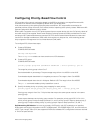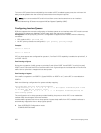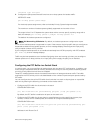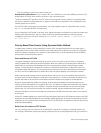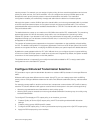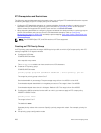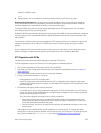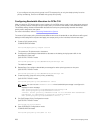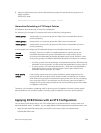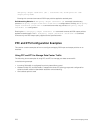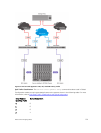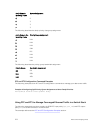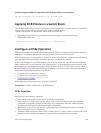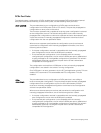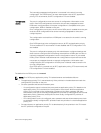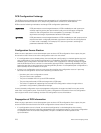7. Apply the QoS output policy with the bandwidth percentage for specified priority queues to an
egress interface.
INTERFACE mode
Dell(conf-if-te-0/1)#service-policy output test12
Hierarchical Scheduling in ETS Output Policies
ETS supports up to three levels of hierarchical scheduling.
For example, you can apply ETS output policies with the following configurations:
Priority group 1 Assigns traffic to one priority queue with 20% of the link bandwidth and strict-
priority scheduling.
Priority group 2 Assigns traffic to one priority queue with 30% of the link bandwidth.
Priority group 3 Assigns traffic to two priority queues with 50% of the link bandwidth and strict-
priority scheduling.
In this example, the configured ETS bandwidth allocation and scheduler behavior is as follows:
Unused
bandwidth
usage:
Normally, if there is no traffic or unused bandwidth for a priority group, the
bandwidth allocated to the group is distributed to the other priority groups
according to the bandwidth percentage allocated to each group. However, when
three priority groups with different bandwidth allocations are used on an interface:
• If priority group 3 has free bandwidth, it is distributed as follows: 20% of the free
bandwidth to priority group 1 and 30% of the free bandwidth to priority group 2.
• If priority group 1 or 2 has free bandwidth, (20 + 30)% of the free bandwidth is
distributed to priority group 3. Priority groups 1 and 2 retain whatever free
bandwidth remains up to the (20+ 30)%.
Strict-priority
groups:
If two priority groups have strict-priority scheduling, traffic assigned from the
priority group with the higher priority-queue number is scheduled first. However,
when three priority groups are used and two groups have strict-priority scheduling
(such as groups 1 and 3 in the example), the strict priority group whose traffic is
mapped to one queue takes precedence over the strict priority group whose traffic
is mapped to two queues.
Therefore, in this example, scheduling traffic to priority group 1 (mapped to one strict-priority queue)
takes precedence over scheduling traffic to priority group 3 (mapped to two strict-priority queues).
Applying DCB Policies with an ETS Configuration
You can apply a DCB output policy with ETS configuration to all stacked ports in a switch stack or an
individual stacked switch. In addition, you can apply different DCB output policies to different stack units.
• Apply the specified DCB output policy on all ports of the switch stack or a stacked switch.
CONFIGURATION mode
Data Center Bridging (DCB)
269



